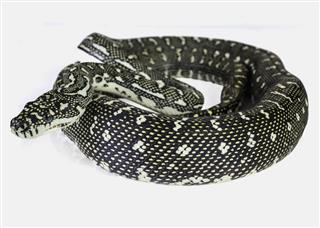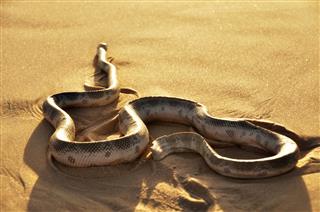
Snakes are often found to go hungry for long intervals. Such behavior is mostly observed after they have huge meals. Here are some interesting facts about how snakes digest their food.
Did you know?
The digestive enzymes of snakes are so powerful that they can dissolve bones and egg shells. However, hair, claws, insect shells, etc., are usually excreted by these animals.
Snakes have long, narrow, and limbless bodies. Due to this body shape, their internal organs are arranged in a linear manner. As far as the digestive system of snakes is concerned, it runs through almost the entire length of the body. It starts from the buccal cavity, and extends till the anus. The system is well adapted to the feeding behavior of these animals.
Most snakes often exhibit an intermittent feeding behavior with long intervals between meals. Such intervals may span from a few days to weeks, months, and even years in some cases. An interesting fact is that when an infrequent feeder snake gets active, their digestive system remains inactive. After the meal, the snake turns inactive, but the digestive system gets active. They have specialized digestive systems that undergo rapid growth to cope up with the increased demands of digestion. The increased rate of activity slows down once the meal is digested completely. The digestive system shrinks in size, and turns dormant. Let us take a look at how snakes digest their food.
Digestion in Snakes
Intake
The digestive system of a snake starts from the mouth, which is highly modified to swallow the prey in whole. The jaws as well as parts of their skulls are flexible enough to swallow large prey. Another interesting fact is that, in most cases, the prey is swallowed (without chewing) headfirst, so that its horns, limbs, hair, feathers, or spines, do not get stuck and cause injury to the snake. However, such injuries may happen in some cases. The process of digestion begins in the mouth, as the prey is coated with saliva that contains digestive enzymes. The process of swallowing may take several hours or even days.

Digestion
The long tube-like structure that connects the mouth with the stomach is called the esophagus. In snakes, the esophagus is muscular as well as lengthy. It may measure one-quarter to one-half the body length of the snake. The organ is highly distensible to facilitate movement of large prey to the stomach. It is the contraction of the muscles on the walls of the esophagus that aids to move the prey to the stomach. The cells on the stomach walls produce strong digestive juices that help dissolve the prey. Even the small intestine produces some secretions that help in the process of digestion.
The small intestine is a tube-like structure that absorbs nutrients from the food. The liver too, produces bile that is stored in the gallbladder. The bile is sent through the duodenum to the small intestine, so as to break down fat. The pancreas also produces some digestive juices. The food is sent to the large intestine, through the cecum. As compared to other parts of the digestive system of a snake, the large intestine is the least muscular and thin-walled structure. The large intestine ends in the rectum, which, in turn, opens up to the cloaca that leads to the opening outside the body. Everything, except the claws and hair of the prey, is digested by snakes.
Factors that Affect Digestion
Temperature
This is one of the most important factors that affect the digestive process in snakes. Their internal body temperature is affected by the atmospheric temperature, and they require warm temperature for proper digestion. This is the reason why snakes are found basking in the Sun after having a very large meal. Another technique is to coil up the body to conserve heat. It is said that a temperature range of 28 to 30°C (82 to 86°F) is ideal for digestion in snakes. Sometimes, the snake may expel the swallowed prey, if the temperature is very low. It has been observed that a considerable drop in temperature may be the reason for fasting, practiced by some snakes from late fall to early spring.
According to a study conducted on Indian pythons, it took four to five days for a snake to completely digest a rabbit, when kept at 82 °F. A drop in temperature (71 °F) extended the time taken for digestion to seven days. When the temperature was further lowered (to 64 °F), the prey was left in the snake’s stomach, even after two weeks.
Body Size
The size of the meal of a snake is largely dependent on its own size. The larger the snake, the larger the size of its prey. Even the large-sized ones, like pythons, feed on small animals like mice, when they are juveniles. The adults feed on antelopes, donkeys, deer, etc. However, unlike humans, most snakes consume food that is around 25% of their body weight (in the unfed state), in a single meal. Certain types of pythons are found to swallow prey that are 65 to 95% of their own body weight. The larger the prey, the longer the duration of digestion.
Feeding Intervals
While some snakes feed frequently, there are others who have large meals at longer intervals. In other words, there are frequent and infrequent feeders. As compared to the former, the latter category has very slow digestion. Infrequent feeders have a low metabolic rate, along with lower organ mass, and low rate of nutrient absorption. However, after feeding, their energy rates as well as organ mass shoot up.
According to latest studies, the liver, intestines, and heart of an infrequent feeder snake enlarge as a result of the metabolic spurt. While the size of intestines increases by three to four times, even the cellular lining thickens threefold, after 24 to 48 hours of food consumption. The liver too, displays tremendous cell growth. All these require so much energy that the oxygen intake of the animal increases 60 times. An average snake spends more than one-third to half the energy derived from a single meal, in digestion. Once the food gets out of the large intestine, it takes around a week for the digestive system to return to its normal state, which is retained till the next feeding.
Regurgitation and Vomiting
Both terms refer to the action of expelling food swallowed by the snake. Forceful expulsion of partially digested food from the stomach is vomiting, whereas in regurgitation, the undigested food is expelled from the esophagus. The most common causes for food expulsion are stress, very low temperature, too large prey, underlying health problems, etc. A prey with foreign microbes in its body may rot inside the body of the snake, and cause distension, which could be a reason for vomiting.
This is only a brief overview of the process of digestion in snakes. They are highly adapted to their feeding behavior, with a digestive system that can remain active or inactive, as per their feeding habits.









